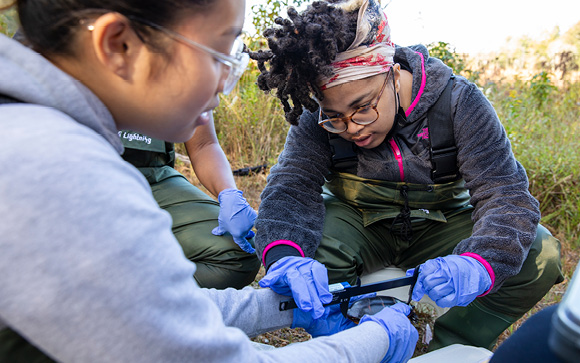October 27, 2021
BSU Students Develop Original Research to Save Fresh Water Turtles
Biology Students Explore Turtle Diets for Clues to Environmental Threats

MEDIA CONTACT: Cassandra Robinson, crobinson@bowiestate.edu, 301-860-4336
(BOWIE, Md.) – From pollution to invasive species introduced by humans to the loss and general degradation of their habitats, many aquatic turtle populations are threatened, with 60 percent of all turtles recently extinct. Bowie State University biology students are conducting original research to save local turtles by examining their ecosystems in the wetlands of the Patuxent Research Refuge in Prince George’s County.
To understand what’s causing turtles to disappear, it’s critical to understand aquatic turtle food preferences and their reaction to changing and overpopulated environments. Through the Course-based Undergraduate Research Experiences (CURE) program, BSU undergraduates are working to understand how aquatic turtles fit into local wetland food webs. The students are getting early and extensive opportunities to participate in research within their fields beyond the traditional classroom setting.
“This is a wonderful experience for our students,” said Dr. Anne Wiley, associate professor of environmental science, BSU Department of Natural Sciences. “Usually, it's just the few students who have the great GPA, who get those limited spots in professors’ research laboratories and get the true hands on experience of conducting research. It’s really powerful for every student in the department to have research experiences through the CURE program.”
CURE was one of the things that attracted Dr. Wiley, who joined the Bowie State faculty in 2020. Many of the courses in the natural sciences department incorporate professor’s own research program directly into the class curriculum, which allows the biology students multiple research experiences. Her interest in aquatic freshwater turtles that live in wetlands resulted in the field biology course she introduced this semester.
According to Dr. Wiley, turtles and the wetland ecosystems are currently under threat, which prompted her to develop a study system that allowed the students to look at the problem in different ways. The students in her field biology course, primarily juniors and seniors, designed their own research projects based on the system, instead of having one central question addressed by the entire class.
“What we're trying to do is to help the wildlife refuge increase the biodiversity that's available,” said senior biology major Abdullahi Ismail Iro. “The goal is to eventually learn how to help the turtles compete within their own environment. What the wildlife refuge needs to know is what's actually happening on the ground, and as researchers that's what we're able to do.”
The students selected three research topics for the class: the dietary effects of coloration on turtles, the effects of the invasive rusty crayfish on turtles, and the sex and age based diet.
Working at the 12,000-acre refuge near the BSU campus, the students capture eastern painted turtles and collect toenail samples to get clues to the turtles’ food source using a method called stable isotype analysis. They collaborate with the Smithsonian Institution’s Stable Mass Spectrometry Facility to conduct the analysis. The field biology class is using stable isotope ratios in turtle toenails to quantify what is mostly hidden from the human eye—the feeding relationships that bind turtles to the rest of their food web.
The students also photograph the turtles to examine the coloration. They use the isotope analysis to determine whether the coloration is influenced by diet in both male and female turtles and whether they are consuming certain foods based on their age and their sex. While researching the sex and age based diet, the students examine what the turtles are eating at what points of their lives. Another group is studying how the rusty crayfish is potentially competing with the freshwater turtles.
“One of my goals in field biology is to pique student curiosity by throwing them into the middle of their study subject—the ecosystems of Maryland,” said Dr. Wiley. “To that end, more than half of all class meeting hours are conducted outside, in natural environments ranging from wetlands to forests.”
“The class is super fun, and Dr. Wiley and the students are amazing,” said India Barnett, a senior science education major and teaching assistant for the class. “With everything that's going on in our world like climate change and other environmental issues, our students like when we talk about environmental justice and other related topics. It's important for them to be able to gain an appreciation and understanding for their environment, so that we can move forward in a positive direction by doing this research.”
“The great thing about CURE is that unlike the internship method, every student is qualified to do research from first-year freshman year courses through senior year,” said Dr. George Ude, chair and professor, Department of Natural Resources. “The research the students conduct along with their findings allows them to take part in the research work of the faculty and become published authors while studying their major. Our plan is to eventually infuse the CURE program into all disciplines.”
###
About Bowie State University
Bowie State University (BSU) is an important higher education access portal for qualified persons from diverse academic and socioeconomic backgrounds, seeking a high-quality and affordable public comprehensive university. The university places special emphasis on the science, technology, cybersecurity, teacher education, business, and nursing disciplines within the context of a liberal arts education. For more information about BSU, visit bowiestate.edu.
